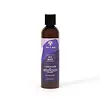What's inside
What's inside
 Key Ingredients
Key Ingredients

 Benefits
Benefits

 Concerns
Concerns

 Ingredients Side-by-side
Ingredients Side-by-side

Water
Skin ConditioningGlycerin
HumectantBetaine
HumectantCetearyl Alcohol
EmollientCetyl Alcohol
EmollientLinum Usitatissimum Seed Extract
PerfumingBrassicamidopropyl Dimethylamine
Skin ConditioningPolyglyceryl-3 Betainate Acetate
Oryza Sativa Extract
AbsorbentBiotin
AntiseborrhoeicCeramide NP
Skin ConditioningPhytosterols
Skin ConditioningInositol
HumectantCopper Tripeptide-1
Skin ConditioningSerenoa Serrulata Fruit Extract
Skin ConditioningCocos Nucifera Oil
MaskingCetyl Esters
EmollientC12-15 Alkyl Lactate
EmollientLactic Acid
BufferingLauramidopropyl Hydroxysultaine
CleansingCaprylhydroxamic Acid
Sodium Chloride
MaskingCaprylyl Glycol
EmollientPotassium Sorbate
PreservativeSodium Benzoate
MaskingWater, Glycerin, Betaine, Cetearyl Alcohol, Cetyl Alcohol, Linum Usitatissimum Seed Extract, Brassicamidopropyl Dimethylamine, Polyglyceryl-3 Betainate Acetate, Oryza Sativa Extract, Biotin, Ceramide NP, Phytosterols, Inositol, Copper Tripeptide-1, Serenoa Serrulata Fruit Extract, Cocos Nucifera Oil, Cetyl Esters, C12-15 Alkyl Lactate, Lactic Acid, Lauramidopropyl Hydroxysultaine, Caprylhydroxamic Acid, Sodium Chloride, Caprylyl Glycol, Potassium Sorbate, Sodium Benzoate
Water
Skin ConditioningCetearyl Alcohol
EmollientBrassica Campestris Seed Oil
Skin ConditioningCaprylic/Capric Triglyceride
MaskingArgania Spinosa Kernel Oil
EmollientButyrospermum Parkii Butter
Skin ConditioningGlycerin
HumectantCetrimonium Chloride
AntimicrobialParfum
MaskingTocopherol
AntioxidantHelianthus Annuus Seed Oil
EmollientCitric Acid
BufferingSodium Benzoate
MaskingPotassium Sorbate
PreservativeBenzyl Salicylate
PerfumingLimonene
PerfumingLinalool
PerfumingWater, Cetearyl Alcohol, Brassica Campestris Seed Oil, Caprylic/Capric Triglyceride, Argania Spinosa Kernel Oil, Butyrospermum Parkii Butter, Glycerin, Cetrimonium Chloride, Parfum, Tocopherol, Helianthus Annuus Seed Oil, Citric Acid, Sodium Benzoate, Potassium Sorbate, Benzyl Salicylate, Limonene, Linalool
Ingredients Explained
These ingredients are found in both products.
Ingredients higher up in an ingredient list are typically present in a larger amount.
Cetearyl alcohol is a mixture of two fatty alcohols: cetyl alcohol and stearyl alcohol. It is mainly used as an emulsifier. Emulsifiers help prevent the separation of oils and products. Due to its composition, it can also be used to thicken a product or help create foam.
Cetearyl alcohol is an emollient. Emollients help soothe and hydrate the skin by trapping moisture.
Studies show Cetearyl alcohol is non-toxic and non-irritating. The FDA allows products labeled "alcohol-free" to have fatty alcohols.
This ingredient is usually derived from plant oils such as palm, vegetable, or coconut oils. There is debate on whether this ingredient will cause acne.
Due to the fatty acid base, this ingredient may not be Malassezia folliculitis safe.
Learn more about Cetearyl AlcoholGlycerin is already naturally found in your skin. It helps moisturize and protect your skin.
A study from 2016 found glycerin to be more effective as a humectant than AHAs and hyaluronic acid.
As a humectant, it helps the skin stay hydrated by pulling moisture to your skin. The low molecular weight of glycerin allows it to pull moisture into the deeper layers of your skin.
Hydrated skin improves your skin barrier; Your skin barrier helps protect against irritants and bacteria.
Glycerin has also been found to have antimicrobial and antiviral properties. Due to these properties, glycerin is often used in wound and burn treatments.
In cosmetics, glycerin is usually derived from plants such as soybean or palm. However, it can also be sourced from animals, such as tallow or animal fat.
This ingredient is organic, colorless, odorless, and non-toxic.
Glycerin is the name for this ingredient in American English. British English uses Glycerol/Glycerine.
Learn more about GlycerinPotassium Sorbate is a preservative used to prevent yeast and mold in products. It is commonly found in both cosmetic and food products.
This ingredient comes from potassium salt derived from sorbic acid. Sorbic acid is a natural antibiotic and effective against fungus.
Both potassium sorbate and sorbic acid can be found in baked goods, cheeses, dried meats, dried fruit, ice cream, pickles, wine, yogurt, and more.
You'll often find this ingredient used with other preservatives.
Learn more about Potassium SorbateSodium Benzoate is a preservative. It's used in both cosmetic and food products to inhibit the growth of mold and bacteria. It is typically produced synthetically.
Both the US FDA and EU Health Committee have approved the use of sodium benzoate. In the US, levels of 0.1% (of the total product) are allowed.
Sodium benzoate works as a preservative by inhibiting the growth of bacteria inside of cells. It prevents the cell from fermenting a type of sugar using an enzyme called phosphofructokinase.
It is the salt of benzoic acid. Foods containing sodium benzoate include soda, salad dressings, condiments, fruit juices, wines, and snack foods.
Studies for using ascorbic acid and sodium benzoate in cosmetics are lacking, especially in skincare routines with multiple steps.
We always recommend speaking with a professional, such as a dermatologist, if you have any concerns.
Learn more about Sodium BenzoateWater. It's the most common cosmetic ingredient of all. You'll usually see it at the top of ingredient lists, meaning that it makes up the largest part of the product.
So why is it so popular? Water most often acts as a solvent - this means that it helps dissolve other ingredients into the formulation.
You'll also recognize water as that liquid we all need to stay alive. If you see this, drink a glass of water. Stay hydrated!
Learn more about Water